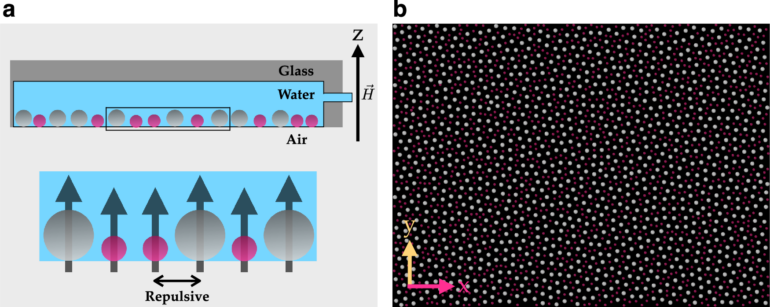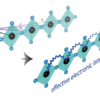The amorphous state of matter is the most abundant form of visible matter in the universe, and includes all structurally disordered systems, such as biological cells or essential materials like glass and polymers.
An amorphous material is a solid whose molecules and atoms form disordered structures, meaning that they do not occupy regular, well-defined positions in space.
This is the opposite of what happens in crystals, whose ordered structure facilitates their mathematical description, as well as the identification of those “defects,” which practically control the physical properties of crystals, such as their plastic yielding and melting, or the way an electric current propagates through them.
Of particular importance are topological defects, which are mathematically described as points of singularity within an ordered pattern, and around which the integral of a certain quantity changes its value after a full loop around the defect.
Well-known examples of topological defects, which control the mechanical properties of a system, are vortices, anti-vortices, solitons and dislocations.
In amorphous systems such as glasses, or a random network of neuronal connections, topological defects were observed for the first time in numerical simulations only in 2021, thanks to computer simulations of glassy materials conducted by my research team at the University of Milan, and in collaboration with Matteo Baggioli at Shanghai Jiao-Tong University and Tim Sirk at US Army Research Laboratory.
Later on, other teams in China, France and the U.S. replicated our observation in different glassy systems simulated numerically on a computer. Apart from those observations in computer simulations, no evidence of the existence of these topological defects in real-life amorphous materials had been reported until today.
Now, thanks to particular methods of numerical analysis applied to the treatment of experimental data from video microscopy, my collaborators and I have managed to clearly identify the topological defects in an amorphous colloidal glass created in the lab by randomly assembling magnetic colloidal particles.
The findings are published in the journal Nature Communications.
The interaction between the particles can be finely tuned by an external magnetic field. The experimental data were collected at the University of Konstanz (Germany) by my colleague Prof. Peter Keim, with whom I began to collaborate while both of us were in Göttingen, respectively, as a Max Planck group leader (Peter) and a visiting Gauss-Professor (myself) supported by the Göttingen Academy of Sciences.
I personally believe that the experimental demonstration of the existence of topological defects in disordered systems is a turning point in condensed matter physics because it paves the way for the possibility to rationally control and manipulate the physical properties of amorphous materials and systems, with implications for artificial intelligence, the nervous systems of living beings and even the large-scale structure of the cosmos.
In ongoing work, I am collaborating with experimentalists to detect the newly discovered topological defects also in amorphous materials subject to deformation, in an attempt to identify and predict the regions in the material that are more prone to mechanical failure.
This story is part of Science X Dialog, where researchers can report findings from their published research articles. Visit this page for information about Science X Dialog and how to participate.
More information:
Vinay Vaibhav et al, Experimental identification of topological defects in 2D colloidal glass, Nature Communications (2025). DOI: 10.1038/s41467-024-54857-z
Bio:
Alessio Zaccone received his Ph.D. from the Department of Chemistry of ETH Zurich in 2010. From 2010 till 2014 he was an Oppenheimer Research Fellow at the Cavendish Laboratory, University of Cambridge.
After being on the faculty of Technical University Munich (2014–2015) and of University of Cambridge (2015–2018), he has been a full professor and chair of theoretical physics in the Department of Physics at the University of Milano since 2022. Awards include the ETH Silver Medal, the 2020 Gauss Professorship of the Göttingen Academy of Sciences, the Fellowship of Queens’ College Cambridge, and an ERC Consolidator grant (“Multimech”).
Research contributions include the analytical solution to the jamming transition problem (Zaccone & Scossa-Romano PRB 2011), the analytical solution to the random close packing problem in 2d and 3d (Zaccone PRL 2022), the theory of thermally-activated reaction rate processes in shear flows (Zaccone et al PRE 2009), the theory of crystal nucleation under shear flow (Mura & Zaccone PRE 2016), the theoretical prediction of boson-like peaks in the vibrational spectra of crystals (Milkus & Zaccone PRB 2016; Baggioli & Zaccone PRL 2019), the theory of the glass transition in polymers (Zaccone & Terentjev PRL 2013), the theoretical and computational discovery of topological defects in glasses (Baggioli, Kriuchevskyi, Sirk, Zaccone PRL 2021), and the theoretical prediction of superconductivity enhancement effects due to phonon damping (Setty, Baggioli, Zaccone PRB 2020).
Research interests range from the statistical physics of disordered systems (random packings, jamming, glasses and the glass transition, colloids, nonequilibrium thermodynamics) to solid-state physics and superconductivity.
Citation:
Physicists experimentally observe topological defects in glasses for the first time (2025, January 13)



